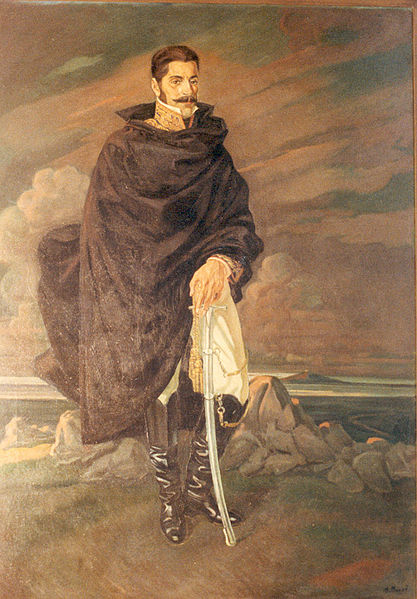<Back to Index>
- Mineralogist Jean Baptiste Louis Romé de l'Isle, 1736
- Painter Rufino Tamayo, 1899
- 4th President of Uruguay Manuel Ceferino Oribe y Viana, 1792
PAGE SPONSOR

Manuel Ceferino Oribe y Viana (August 26, 1792 - November 12, 1857) was the fourth president of Uruguay.
Manuel Oribe was the son of Captain Francisco Oribe and María Francisca Viana, a descendant of the first governor of Montevideo, José Joaquín de Viana. At the beginning of the revolution of independence in the Rio de la Plata he enlisted in the patriot ranks as a volunteer.
His baptism of fire took place in the battle of Cerrito, on December 31, 1812, during the second siege of Montevideo, feat of arms that ended in a victory for the Patriots. He took part alongside José Gervasio Artigas's resistance against the Luso - Brazilian invasion in 1816.
In
late 1817, with Montevideo already fallen into the hands of the
Luso - Brazilians, Oribe moved to Buenos Aires along with his brother
Ignacio and Colonel Rufino Bauza, taking with him the Freedmen
Battalion and an artillery battalion. The
historian Francisco Bauza, son of Rufino Bauza, in his "Historia de la
dominación española en el Uruguay" (1880 - 1882), argued
that given the almost obsessive insistence of Artigas to name his
favorite, Fructuoso Rivera, as military commander and the south of
Río Negro to face the invasion, Rufino Bauza and Manuel Oribe
would have come out against a situation that led to a violent exchange
of words with Artigas, whose military situation was going out of hand. Due to the
personal rivalry between Rivera and Oribe, which apparently dates of
such events, the young officer decided to abandon his boss. Carlos
Federico Lecor, commander of the occupying forces, offered no hindrance
to the passage of eastern officials in Buenos Aires, even though he
could not attract them to his cause. Rivera and his people were in the
service of the invader Lusitanians. In
Buenos Aires, known by the certifying of stationery at the time, since
1819, Oribe, along with other easterns as Santiago Vazquez and
residents who were equally opposed to the Brazilian Portuguese
occupation and Artigas, had built a secret Masonic society, called the
Society of the Eastern Knights, who waited at least until 1821,
Cisplatin Congress to undertake a return to the, since then, called
Cisplatina Province and begin work to reverse the situation. Meanwhile,
following the defeat of Artigas (and even before it) another section of
the eastern elite had acceded to the occupants, accepting and in fact
closely collaborating with the Portuguese. This was the only faction to
be represented in Congress Cisplatin, 1821. The
occupation of the Banda Oriental and its transformation into
"Cisplatina Province" by the Portuguese and Brazilian troops had
resulted in additional fracture of the leading factions, which had since
lined up in two groups separated by the acceptance or rejection of that
military presence: Those groups would eventually become the Colorado and White party. Oribe served as President of Uruguay between 1835 and 1838. He was a big supporter of Juan Manuel de Rosas in Argentina, who in turn supported him. In 1838 he was forced to resign by Fructuoso Rivera but started a rebel army and began a long civil war which lasted until 1851. After a siege of the capital Montevideo which lasted for 8 years, Oribe was defeated in 1851 with help from Brazil and Argentine rebels who were against Rosas.
Oribe’s supporters became known as the Nationals or Blancos, while his opponents became the Colorados. These remained the main political factions until a third – the Frente Amplio – emerged in the late 20th century.